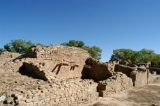
Aztec Ruins National Monument
Encyclopedia
The Aztec Ruins National Monument preserves ancestral Pueblo
structures in north-western New Mexico
, United States, located close to the town of Aztec
and northeast of Farmington
, near the Animas River
. Salmon Ruins
and Heritage Park, with more ancestral Pueblo structures, lies a short distance to the south, just west of Bloomfield
near the San Juan River.
The buildings date back to the 11th to 13th centuries, and the misnomer attributing them to the Aztec
civilization can be traced back to early American settlers in the mid-19th century. The actual construction was by the ancestral Puebloans, the Anasazi.
The site was declared "Aztec Ruin National Monument
" on January 24, 1923, and with a boundary change it was renamed "Ruins" on July 2, 1928. As an historical property of the National Park Service
the National Monument was administratively listed on the National Register of Historic Places
on October 15, 1966. Aztec Ruins was added to the UNESCO
list of World Heritage Sites, as part of the Chaco Culture National Historical Park
, on December 8, 1987.
Pueblo
Pueblo is a term used to describe modern communities of Native Americans in the Southwestern United States of America. The first Spanish explorers of the Southwest used this term to describe the communities housed in apartment-like structures built of stone, adobe mud, and other local material...
structures in north-western New Mexico
New Mexico
New Mexico is a state located in the southwest and western regions of the United States. New Mexico is also usually considered one of the Mountain States. With a population density of 16 per square mile, New Mexico is the sixth-most sparsely inhabited U.S...
, United States, located close to the town of Aztec
Aztec, New Mexico
Aztec is a city in San Juan County, New Mexico, United States. It is part of the Farmington, New Mexico Metropolitan Statistical Area. The population was 6,378 at the 2000 census. It is the county seat of San Juan County...
and northeast of Farmington
Farmington, New Mexico
Farmington is a city in San Juan County in the U.S. state of New Mexico. As of the 2010 U.S. Census the city had a total population of 45,877 people. Farmington makes up one of the four Metropolitan Statistical Areas in New Mexico. The U.S...
, near the Animas River
Animas River
Animas River is a river in the western United States, a tributary of the San Juan River, part of the Colorado River System. The Spanish named the river "Rio de las Animas Perdidas", "River of the Lost Souls". It is also the last free-flowing river in Colorado. The river's free-flowing status...
. Salmon Ruins
Salmon Ruins
Salmon Ruins is a site in the far northwest of the American state of New Mexico hosting a Chacoan Anasazi great house built between approximately 1088 CE and 1100 CE. The complex contained around 150 ground-level rooms arranged into a D-shaped profile; up to 100 second-floor rooms are estimated to...
and Heritage Park, with more ancestral Pueblo structures, lies a short distance to the south, just west of Bloomfield
Bloomfield, New Mexico
Bloomfield is a city in San Juan County, New Mexico, United States. It is part of the Farmington Metropolitan Statistical Area. The population was 6,420 at the 2000 census.-Geography:Bloomfield is located at ....
near the San Juan River.
The buildings date back to the 11th to 13th centuries, and the misnomer attributing them to the Aztec
Aztec
The Aztec people were certain ethnic groups of central Mexico, particularly those groups who spoke the Nahuatl language and who dominated large parts of Mesoamerica in the 14th, 15th and 16th centuries, a period referred to as the late post-classic period in Mesoamerican chronology.Aztec is the...
civilization can be traced back to early American settlers in the mid-19th century. The actual construction was by the ancestral Puebloans, the Anasazi.
The site was declared "Aztec Ruin National Monument
U.S. National Monument
A National Monument in the United States is a protected area that is similar to a National Park except that the President of the United States can quickly declare an area of the United States to be a National Monument without the approval of Congress. National monuments receive less funding and...
" on January 24, 1923, and with a boundary change it was renamed "Ruins" on July 2, 1928. As an historical property of the National Park Service
National Park Service
The National Park Service is the U.S. federal agency that manages all national parks, many national monuments, and other conservation and historical properties with various title designations...
the National Monument was administratively listed on the National Register of Historic Places
National Register of Historic Places
The National Register of Historic Places is the United States government's official list of districts, sites, buildings, structures, and objects deemed worthy of preservation...
on October 15, 1966. Aztec Ruins was added to the UNESCO
UNESCO
The United Nations Educational, Scientific and Cultural Organization is a specialized agency of the United Nations...
list of World Heritage Sites, as part of the Chaco Culture National Historical Park
Chaco Culture National Historical Park
Chaco Culture National Historical Park is a United States National Historical Park hosting the densest and most exceptional concentration of pueblos in the American Southwest. The park is located in northwestern New Mexico, between Albuquerque and Farmington, in a remote canyon cut by the Chaco Wash...
, on December 8, 1987.

